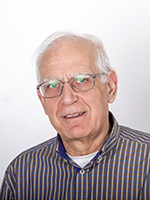Elasticity anisotropy in nanostructured materials
Date: 2024/05/27 - 2024/05/27
Academic Seminar: Elasticity anisotropy in nanostructured materials
Speaker: George Fytas, Professor, S Physical Chemistry in the Department of Materials Science & Technology of the University of Crete
Time: 10:00 - 11:30 am, May 27, 2024 (Beijing Time)
Location: CIMC Auditorium (Room 300), JI Long Bin Building
Abstract
Biological composites have low density but are concomitantly strong and tough resisting to plastic deformations and catastrophic fracture. Such materials consist of high volume fraction of aligned hard inorganic filler and soft biopolymer layers, periodically arranged. In spite of extensive research, the mechanisms for the extraordinary mechanical behaviour of biomaterials are not fully understood hampering rational designs of advanced bioinspired materials. On the experimental side, access to mechanical modulus at most along two symmetry directions by macroscopic tensile test or AFM is insufficient to estimate the full elastic tensor. Here, we introduce the Brillouin Light Spectroscopy (BLS), which is all-optical technique and hence can provide noncontact, non-destructive and label–free access to the complete elasticity of nanostructured materials utilizing the vector nature of the phonon waves at hypersonic (GHz) frequencies.. Phonon propagation in architected hard-soft materials reveals a wealth of unexpected findings not only near the Brillouin zone (BZ) but also at long wavelengths compared to the structure periodicity. In the latter linear acoustic regime, the recorded by BLS dispersion relation, ω (q) (frequency vs wave vector), is utilized for the full characterization of the direction-dependent elasticity enabling the estimation of the material elastic constants. Recent selected examples will include enhanced elasticity in polymer grafted (inorganic core) nanoparticles (GNP), strong elasticity anisotropy in nacre mimetic hybrids, liquid-crystalline elastomers and spider silk and oriented molecular glasses. All these systems have to be optically transparent. For non-transparent, localized (q-independent) elastic excitations in the realm of colloids can be resolved by BLS. Particle vibrational spectroscopy has emerged as a new tool for the measurement of elasticity, glass transition and interactions at nanoscale. Scrutinizing structure-controlled mechanics helps establish a reliable predictive power that will open new application pathways of soft-matter-based elasticity and phonon mediated thermal conduction.
Biography
George Fytas is professor of Physical Chemistry in the Department of Materials Science & Technology of the University of Crete, affiliated member of IESL/FORTH and External Member of the Max Planck Institute for Polymer Research in Mainz. George Fytas has received the BS in Chemistry Department of the University of Athens and the PhD with from the Technical University of Hannover in Germany. He performed his postdoc research in SUNY at Stony Brook in USA and received his habilitation from the University of Bielefeld in Germany. George Fytas trained 45 PhD students and 27 postdocs who all have successful carriers worldwide. He published over 285 peer reviewed scientific articles (Science, Nature (Nature -Materials,-Nanotechnology,-Chemistry,-Communications), Nanoletters, Angewandte Chemie JACS, ACS Nano, Adv. Mater, PRL), one edited book and 11 reviews in books.
He has received honor professorship offer from the University of Patras and the first FO.R.T.H Award for Basic Research (1999). He was nominated: as external member of Max Planck Society (1998); Received a Humboldt Senior Research Award (2002); Became a Fellow of the American Physical Society (2004); Received an invited professorship in the University of Lille (2009, 2012); is member of the Institute for Complex Molecular Systems ICMS (TU/e), Eindhoven; Adjunct Professor at the University of Akron (2013); distinguished Fellow of Tongji University in Shanghai and Shanxi University in Taiyuan (2018); specially appointed professor in School of Materials and Chemical Technology, Tokyo Institute of Technology (2019); and awarded with ERC 2015 Advanced Grant. He served as Regional Editor of Colloid & Polymer Science and member of the Editorial Advisory Board in four international journals. His mission is the basic understanding and prediction of the behavior and tunability of unconventional physical properties of structured soft materials with spatiotemporal complexity.
